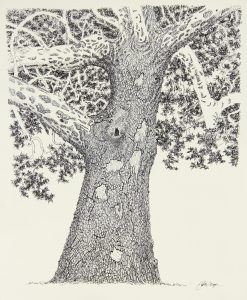Good books and walks in the woods are the only things keeping me sane during the pandemic, so I jumped at the opportunity to tromp around one recent morning with the author of a book I had just finished. It was during walks just like this that Lawrencian John Hooge began dreaming up his Leafensong nature fantasy series. Part one, First Telling, was published last fall with a sequel soon to come.
“I used to walk out here long before it was the Mutt Run,” he says as we set out on a hike just east of the Clinton Lake Dam, in which he promises to show me some of his favorite trees and explain how a longtime bankruptcy lawyer ends up writing and illustrating a children’s book set in a post-apocalyptic world populated by hyperintelligent squirrels. His two gracefully aging pointers lead the way, and my rambunctious lab heeler pup surprisingly manages not to knock anyone down today.
Hooge’s Leafensong is that rarest of beasts, a true all-ages novel in the vein of Tolkein’s Lord of the Rings trilogy and Richard Adams’ Watership Down. Hooge cites the latter as an inspiration and an all-time favorite, which blew his mind when he first read it. His own book focuses on the lives of a group of banded squirrels (a species of his own invention) in a mysterious future world no longer inhabited by humans. The book reveals a complex society on the brink of war with a competitor species. Well-developed characters abound, and Hooge’s world-building steeps readers in the culture of the squirrels, who sing as a primary form of self-expression. His own numerous pen and ink illustrations of trees and their occupants provide atmospheric visuals.
I ask when his interest in art began, and he vaguely recalls winning an award with a picture of a boat he drew as a kid in growing up in Nebraska. But he credits his wife, Claudia, for encouraging him as an adult, when she gave him a set of steel tip pens and India ink, after which he checked out books on how to use them from the library (props to our art collections, then and now!). He illustrated one of his wife’s poems, and drew historic buildings, many of which appeared in commemorative calendars published by the Watkins Museum. But most of all, the trees he loved to look at on his walks in the woods—the honey locusts, burr oaks, and sycamores later to inhabit Leafensong--kept him busy.
In fact, the more I listen, the more I think the word “busy” describes Hooge best. He mentions offhandedly several lifetimes’ worth of pursuits over the course of our walk: Pounding spikes on the railroad, building submarines, graduating law school, lawyering in a stint as a prosecutor and handling other types of cases before finding his niche in bankruptcy court, bringing up two kids with his wife of over 45 years, devising his own screen printing equipment, hunting pheasant and quail, constructing a treehouse shaped like a boat, building an actual boat--a canoe--with his grandkids (“Every girl ought to grow up knowing how to steam bend wood”), and, just now, crafting homemade paddles for it. Whew.
Hooge says it was “an emotional time” when the canoe and the first volume of Leafensong were finally finished, because in moments of doubt he had been unsure of their eventual completion. “I couldn’t have done it without Jenea,” he says of his daughter, Jenea Havener, also a Lawrence resident, who has helped edit and shape Leafensong and bring it to press. “It really changed our relationship.”
“I’ve worked on these books for 37 years,” Hooge muses. “I would walk, and these characters, this story, came into my head.” He tells me of the sign hanging by his desk that reads: “I live in my own little world, but it’s okay, they know me there.”
Here’s hoping “they” keep the story and the pictures coming.
John Hooge’s Walks in the Woods (and Some Favorite Trees)
Always on the lookout for new places to roam, I asked Hooge to recommend some spots. He gave me a great list, and each location makes a nice destination for a local, socially distanced adventure:
Woodridge Primitive Park and Campground: Hike and camp along this 4.5 mile trail on the west side of Clinton Lake.
Signal Oak: The towering white oak that once stood just north of Baldwin City is gone, but what remains is the best panoramic view in Douglas County. Look north and see across the wooded valley to Blue Mound. Settlers once hung lanterns here to warn of border raiders on the move. The light could be spotted from Blue Mound, where another lantern was lit to relay the message to Mount Oread, in Lawrence.
Delaware Marsh: Hike a 1.75 mile trail through this wetland located adjacent to the Delaware River, just below the Perry Lake Dam.
Burr Oak at 1220 E. 12th Street: Studio 804, the sustainable architecture program at the University of Kansas, designed this home to incorporate the state’s 2nd largest burr oak.
The Mutt Run at Clinton Lake: Dogs love it, but it’s a great place for people, too. Head south from the parking lot toward fields, woods, and the Wakarusa River. Just northwest of here is Sesquicentennial Point, one of the best places around to watch a sunrise.
-Dan Coleman is a Collection Development Librarian at Lawrence Public Library.




Add a comment to: A Walk in the Woods with John Hooge